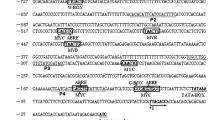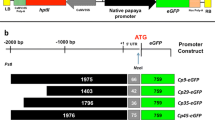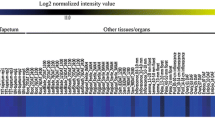Abstract
Unlike xylem, which is primarily composed of dead cells in vascular bundles, phloem has living cells. It transports organic nutrients and long-distance communication signals to all parts of plants. In this report, we describe a promoter from Populus trichocarpa that drives strong gene expression in a phloem tissue-specific manner. First, we identified five candidate genes with strong expression in the developing phloem (DP) tissue from whole-transcriptome gene chip analyses of different tissue types of poplar. The putative promoter sequences of them were isolated and tested for their promoter activity in transgenic Arabidopsis plants. Among them, a promoter of the Potri.001G340200.1 gene (called the PtrDP3 promoter) was identified that has the strongest activity in phloem tissue. PtrDP3 promoter activity was found exclusively in phloem cells of the stem and root tissues of transgenic Arabidopsis plants, which was reproduced in the transgenic poplar plants. The phloemspecific activity of the PtrDP3 promoter was detected as early as in three-day-old seedlings and was not affected by abiotic stresses or exogenously applied plant hormones in transgenic Arabidopsis plants. Promoter deletion analysis identified a 100-bp regulatory region of the PtrDP3 promoter, which is necessary to drive phloem specific expression. This study provides evidence of a strong phloem-specific promoter that is suitable for phloem-specific biotechnological modifications in plants.
Similar content being viewed by others
References
Anstead JA, Froelich DR, Knoblauch M, Thompson GA (2012) Arabidopsis P-protein filament formation requires both AtSEOR1 and AtSEOR2. Plant Cell Physiol 53:1033–1042
Baucher M, Halpin C, Petit-Conil M, Boerjan W (2003) Lignin: genetic engineering and impact on pulping. Crit Rev Biochem Mol Biol 38:305–350
Bucsenez M, Rüping B, Behrens S, Twyman RM, Noll GA, Prüfer D (2012) Multiple cis-regulatory elements are involved in the complex regulation of the sieve element-specific MtSEO-F1 promoter from Medicago truncatula. Plant Biol 14:714–724
Chen F, Dixon RA (2007) Lignin modification improves fermentable sugar yields for biofuel production. Nature Biotech 25:759–761
Choi YI, Noh EW, Lee HS, Han MS, Lee JS, Choi KS (2005) An efficient and novel plant selectable marker based on organomercurial resistance. J Plant Biol 48:351–355
Clough SJ, Bent AF (1998) Floral dip: a simplified method for Agrobacterium-mediated transformation of Arabidopsis thaliana. Plant J 16:735–743
Coleman HD, Ellis DD, Gilbert M, Mansfield SD (2006) Up-regulation of sucrose synthase and UDP-glucose pyrophosphorylase impacts plant growth and metabolism. Plant Biotechnol J 4:87–101
Coleman HD, Samuels AL, Guy RD, Mansfield SD (2008) Perturbed lignification impacts tree growth in hybrid poplar-a function of sink strength, vascular integrity, and photosynthetic assimilation. Plant Physiol 148:1229–1237
De Rybel B, Mähönen AP, Helariutta Y, Weijers D (2016) Plant vascular development: from early specification to differentiation. Nature Rev Mol Cell Biol 17:30–40
Froelich DR, Mullendore DL, Jensen KH, Ross-Elliott TJ, Anstead JA, Thompson GA, Pélissier HC, Knoblauch M (2011) Phloem ultrastructure and pressure flow: sieve-element-occlusion-related agglomerations do not affect translocation. Plant Cell 23:4428–4445
Han KH, Ko JH, Yang SH (2007) Optimizing lignocellulosic feedstock for improved biofuel productivity and processing. Biofuel Bioprod Biorefin 1:135–146
Harfouche A, Meilan R, Altman A (2011) Tree genetic engineering and applications to sustainable forestry and biomass production. Trend Biotechnol 29:9–17
Hehn A, Rohde W (1998) Characterization of cis-acting elements affecting strength and phloem specificity of the coconut foliar decay virus promoter. J Gen Virol 6:1495–1499
Jefferson RA, Kavanagh TA, Bevan MW (1987) GUS fusions: betaglucuronidase as a sensitive and versatile gene fusion marker in higher plants. EMBO J 6:3901–3907
Jeon HW, Cho JS, Park EJ, Han KH, Choi YI, Ko JH (2016) Developing xylem-preferential expression of PdGA20ox1, a gibberellin 20-oxidase 1 from Pinus densiflora, improves woody biomass production in a hybrid poplar. Plant Biotechnol J 14:1161–1170
Karp A, Richter GM (2011) Meeting the challenge of food and energy security. J Exp Bot 62:3263–3271
Ko JH, Kim HT, Hwang I, Han KH (2012) Tissue-type-specific transcriptome analysis identifies developing xylem-specific promoters in poplar. Plant Biotechnol J 10:587–596
Ko JH, Prassinos C, Keathley D, Han KH (2011) Novel aspects of transcriptional regulation in the winter survival and maintenance mechanism of poplar. Tree Physiol 31:208–225
Nguyen VP, Cho JS, Choi YI, Lee SW, Han KH, Ko JH (2016) Evaluation of a novel promoter from Populus trichocarpa for mature xylem tissue specific gene delivery. Plant Physiol Biochem 104:226–233
No EG, Zhou Y, Loopstra CA (2000) Sequences upstream and downstream of two xylem-specific pine genes influence their expression. Plant Sci 160:77–86
Noll GA, Fontanellaz ME, Rüping B, Ashoub A, Bel AJ, Fischer R, Knoblauch M, Prüfer D (2007) Spatial and temporal regulation of the forisome gene for1 in the phloem during plant development. Plant Mol Biol 65:285–294
Noll GA, Rüping B, Ernst AM, Bucsenez M, Twyman RM, Fischer, R, Prüfer D (2009) The promoters of forisome genes MtSEO2 and MtSEO3 direct gene expression to immature sieve elements in Medicago truncatula and Nicotiana tabacum. Plant Mol Biol Rep 4:526–533
Park EJ, Kim HT, Choi YI, Lee C, Nguyen VP, Jeon HW, Cho JS, Funada R, Pharis RP, Kurepin LV, Ko JH (2015) Overexpression of gibberellin 20-oxidase1 from Pinus densiflora results in enhanced wood formation with gelatinous fiber development in a transgenic hybrid poplar. Tree Physiol 35:1264–1277
Polle A, Janz D, Teichmann T, Lipka V (2013) Poplar genetic engineering: promoting desirable wood characteristics and pest resistance. Appl Microbiol Biotechnol 97:5669–5679
Ragauskas AJ, Williams CK, Davison BH, Britovsek G, Cairney J, Eckert CA, Frederick WJ, Hallett JP, Leak DJ, Liotta CL (2006) The path forward for biofuels and biomaterials. Science 311:484–489
Ratke C, Pawar PMA, Balasubramanian VK, Naumann M, Duncranz ML, Derba-Maceluch M, Gorzs as A, Endo S, Ezcurra I, Mellerowicz EJ (2015) Populus GT43 family members group into distinct sets required for primary and secondary wall xylan biosynthesis and include useful promoters for wood modification. Plant Biotechnol J 13:26–37
Ruiz-Medrano R, Xoconostle-Cázares B, Lucas WJ (2001) The phloem as a conduit for inter-organ communication. Current Opinion in Plant Biol 4:202–209
Ruping B, Ernst AM, Jekat SB, Nordzieke S, Reineke AR, Müller B, Bornberg-Bauer E, Prüfer D, Noll GA (2010) Molecular and phylogenetic characterization of the sieve element occlusion gene family in Fabaceae and non-Fabaceae plants. BMC Plant Biol 10:219
Schneidereit A, Imlau A, Sauer N (2008) Conserved cis-regulatory elements for DNA-binding-with-one-finger and homeo-domainleucine-zipper transcription factors regulate companion cellspecific expression of the Arabidopsis thaliana SUCROSE TRANSPORTER 2 gene. Planta 228(4):651–662
Somerville C (2006) The billion-ton biofuels vision. Science 312(5778):1277
Srivastava VK, Raikwar S, Tuteja N (2014) Cloning and functional characterization of the promoter of PsSEOF1 gene from Pisum sativum under different stress conditions using Agrobacteriummediated transient assay. Plant Signal Behav 9:e29626
Stadler R, Sauer N (1996) The Arabidopsis thaliana AtSUC2 gene is specifically expressed in companion cells. Bot Act 4:299–306
Weng JK, Li X, Bonawitz ND, Chapple C (2008) Emerging strategies of lignin engineering and degradation for cellulosic biofuel production. Cur Opin Biotech 19:166–172
Author information
Authors and Affiliations
Corresponding author
Electronic supplementary material
Rights and permissions
About this article
Cite this article
Nguyen, V.P., Cho, JS., Lee, JH. et al. Identification and functional analysis of a promoter sequence for phloem tissue specific gene expression from Populus trichocarpa . J. Plant Biol. 60, 129–136 (2017). https://doi.org/10.1007/s12374-016-0904-8
Received:
Accepted:
Published:
Issue Date:
DOI: https://doi.org/10.1007/s12374-016-0904-8




